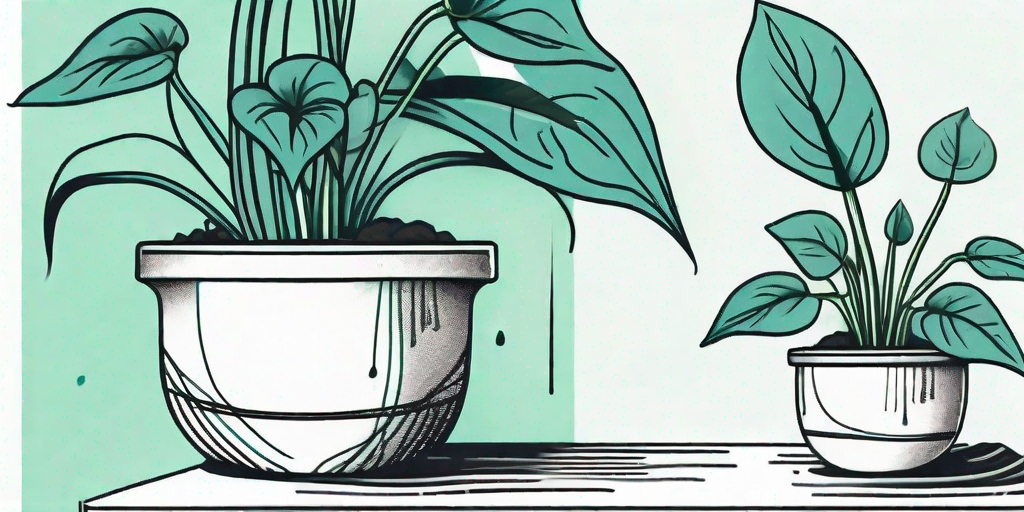
Is your Anthurium looking a little under the weather? Perhaps it's lost its vibrant color, or its leaves have started to droop. Fear not, plant lovers! With a little bit of tender loving care and a good old-fashioned repotting, your Anthurium can be revived and thriving once again. But how do you go about this delicate process? Well, you're in luck! We've got a comprehensive, step-by-step guide to help you through it. So, roll up your sleeves and let's get down to some plant business.
Understanding Your Anthurium
Before we dive into the nitty-gritty of repotting, it's important to understand a bit about the Anthurium. This tropical plant, also known as the Flamingo Flower or Laceleaf, is a popular houseplant due to its striking appearance and relatively easy care. But like any plant, it has its quirks and preferences.
Anthuriums love bright, indirect light and high humidity. They're not big fans of cold temperatures or overwatering. If your Anthurium isn't looking its best, it could be due to a variety of factors. Maybe it's not getting enough light, or perhaps it's sitting in waterlogged soil. Or it could be that it's simply outgrown its current pot and needs a bit more space to spread its roots.
The Signs Your Anthurium Needs Repotting
How do you know when it's time to repot your Anthurium? Well, there are a few tell-tale signs to look out for. If your plant's growth has slowed or stopped, or if the roots are starting to grow out of the drainage holes, it's probably time for a change of scenery. Similarly, if the plant is becoming top-heavy or the soil is drying out too quickly, these are also signs that repotting is needed.
Remember, though, that repotting should generally be done in the spring or early summer, when the plant is in its active growing phase. This gives it the best chance of recovering quickly from the stress of being moved.
Step-by-Step Guide to Repotting Your Anthurium
Now that we've covered the basics, let's get down to the main event: the repotting process. Don't worry, we'll guide you through each step, so even if you're a complete novice, you'll be able to give your Anthurium the fresh start it needs.
Step 1: Gather Your Materials
Before you start, make sure you have everything you need. This includes a new pot (one size larger than the current one), fresh potting soil (preferably a well-draining mix designed for tropical plants), a trowel or spoon, and some gloves (unless you don't mind getting your hands dirty).
It's also a good idea to have a plastic bag or newspaper to catch any loose soil, and a clean, sharp knife or pair of scissors for trimming any dead or damaged roots.
Step 2: Remove the Anthurium from its Current Pot
This can be a bit tricky, especially if the plant is root-bound. If the plant doesn't come out easily, try gently squeezing the sides of the pot to loosen the soil. If it's really stuck, you may need to cut the pot away - but be careful not to damage the roots in the process.
Once the plant is out, gently shake off any loose soil and inspect the roots. If you see any that are black, mushy, or smell bad, these are signs of root rot and should be trimmed away.
Step 3: Place the Anthurium in its New Pot
Now it's time to introduce your Anthurium to its new home. Place a layer of fresh soil at the bottom of the pot, then position the plant so that the top of the root ball is about an inch below the rim. This will allow room for watering.
Fill in around the roots with more soil, pressing gently to remove any air pockets. Make sure the plant is centered and upright, then give it a good watering to settle the soil.
Aftercare: Keeping Your Anthurium Happy
Repotting can be a bit of a shock to a plant's system, so it's important to give your Anthurium some extra TLC in the weeks following the move. Keep it in a warm, bright spot out of direct sunlight, and maintain high humidity if possible. Water when the top inch of soil is dry, but be careful not to overwater.
With the right care, your Anthurium should bounce back quickly and reward you with lush, vibrant growth. And remember, a happy plant is a healthy plant!
Frequently Asked Questions
How often should I repot my Anthurium?
As a general rule, Anthuriums should be repotted every two to three years. However, this can vary depending on the plant's growth rate and the size of its pot. If you notice any of the signs we mentioned earlier, it might be time for a change.
What type of soil should I use?
Anthuriums prefer a well-draining soil mix, such as a peat-based mix with added perlite or orchid bark. Avoid using heavy, water-retaining soils as these can lead to root rot.
Can I propagate my Anthurium during repotting?
Absolutely! If your Anthurium has multiple stems, you can divide it during repotting to create new plants. Just make sure each division has at least one stem and a good set of roots.
There you have it, folks! A comprehensive guide to reviving your Anthurium through repotting. With a little bit of patience and a whole lot of love, your plant will be back to its vibrant self in no time. Happy gardening!















